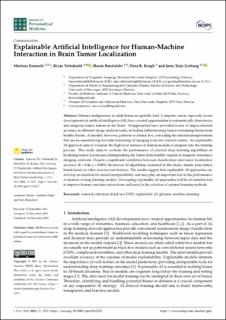| dc.contributor.author | Esmaeili, Morteza | |
| dc.contributor.author | Vettukattil, Riyas | |
| dc.contributor.author | Banitalebi, Hasan | |
| dc.contributor.author | Krogh, Nina R. | |
| dc.contributor.author | Geitung, Jonn Terje | |
| dc.date.accessioned | 2023-02-27T14:51:52Z | |
| dc.date.available | 2023-02-27T14:51:52Z | |
| dc.date.created | 2021-12-02T14:50:13Z | |
| dc.date.issued | 2021 | |
| dc.identifier.citation | Esmaeili, M., Vettukattil, R., Banitalebi, H., Krogh, N. R., & Geitung, J. T. (2021). Explainable artificial intelligence for human-machine interaction in brain tumor localization. Journal of Personalized Medicine, 11(11), 1213. | en_US |
| dc.identifier.issn | 2075-4426 | |
| dc.identifier.uri | https://hdl.handle.net/11250/3054377 | |
| dc.description.abstract | Primary malignancies in adult brains are globally fatal. Computer vision, especially recent developments in artificial intelligence (AI), have created opportunities to automatically characterize and diagnose tumor lesions in the brain. AI approaches have provided scores of unprecedented accuracy in different image analysis tasks, including differentiating tumor-containing brains from healthy brains. AI models, however, perform as a black box, concealing the rational interpretations that are an essential step towards translating AI imaging tools into clinical routine. An explainable AI approach aims to visualize the high-level features of trained models or integrate into the training process. This study aims to evaluate the performance of selected deep-learning algorithms on localizing tumor lesions and distinguishing the lesion from healthy regions in magnetic resonance imaging contrasts. Despite a significant correlation between classification and lesion localization accuracy (R = 0.46, p = 0.005), the known AI algorithms, examined in this study, classify some tumor brains based on other non-relevant features. The results suggest that explainable AI approaches can develop an intuition for model interpretability and may play an important role in the performance evaluation of deep learning models. Developing explainable AI approaches will be an essential tool to improve human–machine interactions and assist in the selection of optimal training methods. | en_US |
| dc.language.iso | eng | en_US |
| dc.publisher | MDPI | en_US |
| dc.rights | Navngivelse 4.0 Internasjonal | * |
| dc.rights.uri | http://creativecommons.org/licenses/by/4.0/deed.no | * |
| dc.title | Explainable artificial intelligence for human-machine interaction in brain tumor localization | en_US |
| dc.type | Peer reviewed | en_US |
| dc.type | Journal article | en_US |
| dc.description.version | publishedVersion | en_US |
| dc.rights.holder | The authors | en_US |
| dc.subject.nsi | VDP::Teknologi: 500 | en_US |
| dc.subject.nsi | VDP::Medisinske Fag: 700 | en_US |
| dc.source.volume | 11 | en_US |
| dc.source.journal | Journal of Personalized Medicine | en_US |
| dc.source.issue | 11 | en_US |
| dc.identifier.doi | 10.3390/jpm11111213 | |
| dc.identifier.cristin | 1963557 | |
| cristin.ispublished | true | |
| cristin.fulltext | original | |
| cristin.qualitycode | 1 | |

